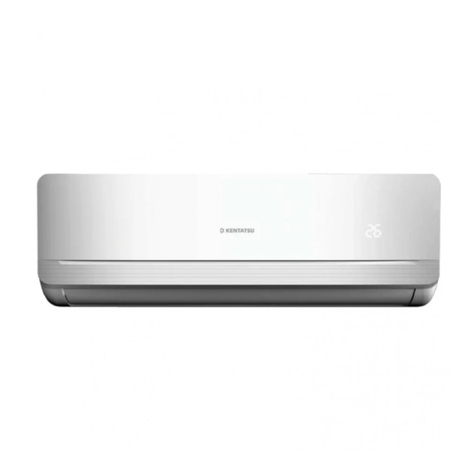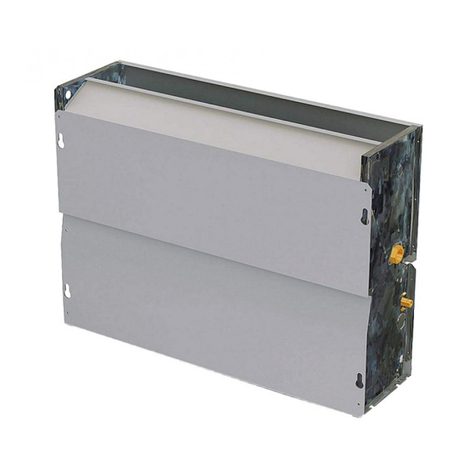
1
CONTENT PAGE
I&O manual
PRECAUTION...........................................................................1
USER....................................................................................................2
INSTALLATION AND MAINTENANCE.......................................................6
DIMENSIONS...................................................................12
SPECIFICATION............................................................................14
Be sure to be in conformity with the local, national and
international laws and regulations.
Read "PRECAUTIONS" carefully before installation.
The following precautions include important safty items.
Observe them and never forget.
Keep this manual in a handy place for future reference.
Before out from factory, FAN COIL UNIT (AIR UNITS) has
passed Fan Coil Overpressure Resistant Test, Statically
and Dynamically Balanced Adjustment, Noise Test, Air
(cool) Volume Test, Electric Property Test, Outline Quality
Detection.
1. PRECAUTIONS
The safety precautions listed here are divided into two categories. In
either case, important safety information is listed which must be read
carefully.
WARNING
After completing the installation, make sure that the unit operates
properly during the start-up operation. Please instruct the customer
on how to operate the unit and keep it maintained.
Be sure only trained and qualified service personnel to
install, repair or service the equipment.
Improper installation, repair, and maintenance may result in
electric shocks, short-circuit, leaks, fire or other damage to
the equipment.
Failure to observe a warning may result in death.
Failure to observe a caution may result in injury or
damage to the equipment.
CAUTION
WARNING
Install according to this installation instructions strictly.
If installation is defective, it will cause water leakage,
electrical shock and fire.
When installing the unit in a small room, take measures
against to keep refrigerant concentration from exceeding
allowable safety limits in the event of refrigerant leakage.
Contact the place of purchase for more information.
Excessive refrigerant in a closed ambient can lead to oxygen
deficiency.
Use the attached accessories parts and specified parts
for installation.
otherwise, it will cause the set to fall, water leakage,
electrical shock and fire.
The appliance must be installed 2.3m above floor.
The appliance shall not be installed in the laundry.
Before obtaining access to terminals, all supply circuits
must be disconnected.
The appliance must be positioned so that the plug is
accessible.
The enclosure of the appliance shall be marked by word,
or by symbols, with the direction of the fluid flow.
For electrical work, follow the local national wiring
standard, regulation and this installation instructions. An
independent circuit and single outlet must be used.
If electrical circuit capacity is not enough or defect in
electrical work, it will cause electrical shock fire.
Use the specified cable and connect tightly and clamp
the cable so that no external force will be acted on the
terminal.
If connection or fixing is not perfect, it will cause heat-up or
fire at the connection.
Wiring routing must be properly arranged so that control
board cover is fixed properly.
If control board cover is not fixed perfectly, it will cause
heat-up at connection point of terminal, fire or electrical
shock.
If the supply cord is damaged, it must be replaced by the
manufacture or its service agent or a similarly qualified
person in order to avoid a hazard.
An all-pole disconnection switch having a contact
separation of at least 3mm in all poles should be
connected in fixed wiring.
When carrying out piping connection, take care not to let
air substances go into refrigeration cycle.
Otherwise, it will cause lower capacity, abnormal high
pressure in the refrigeration cycle.
Do not modify the length of the power supply cord or use
of extension cord, and do not share the single outlet with
other electrical appliances.
Otherwise, it will cause fire or electrical shock.
If the water leaks during installation, ventilate the area
immediately.
After completing the installation work, check that the
water does not leak.
The cool water in the unit is not lower than 3℃, hot water is
not higher than 65℃. Water in the unit must clean, air quality
must meet to the standard of PH=6.5~7.5.































